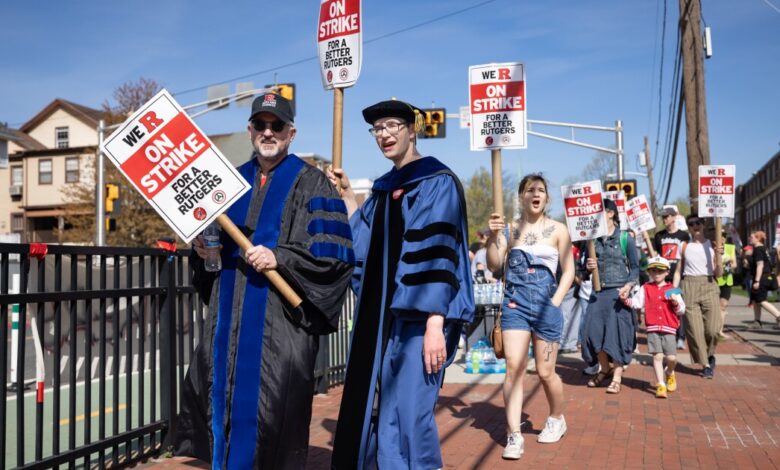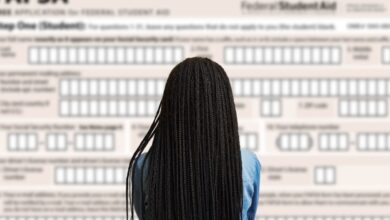Striking Faculty and Grad Students Won Big Pay Raises This Academic Year

[ad_1]
Higher-ed unions had their most successful academic year in recent memory. A series of strikes led to changes that graduate students and faculty members touted as big wins: better wages, more benefits, and improved working conditions.
The work stoppages, which often lasted weeks, disrupted campuses. Many graduate students and faculty weren’t teaching their classes; in some cases, final exams and grades were delayed. Things got so bad in New Jersey, for instance, that the governor felt the need to step in and mediate between the state’s flagship public university and its faculty union in hopes of staving off a court battle.
The conflicts stemmed from a convergence of trends in higher education and the broader U.S. economy. Among them are colleges’ growing reliance on contingent faculty and a cutthroat academic job market, as well as soaring living costs and a burgeoning labor movement.
Here’s a rundown of six institutions where strikes this past year resulted in pay raises for graduate students and faculty members.
University of California
A standoff across the University of California system went on for six weeks, from early November to late December. The UC strike of 48,000 graduate students, postdocs, and researchers, the largest in higher-ed history, proved influential — and prompted even more union activity on campuses this spring.
After a 40-day work stoppage, the unions secured base pay increases ranging from 55 to 80 percent for academic employees and 25 to 80 percent for graduate-student researchers. For example, for a first-year teaching assistant, the minimum annual salary will increase to $36,000 from $25,000 by 2024. However, some student workers have argued that the cost of living near many UC campuses remains significantly higher than those minimums.
“Our members stood up to show the university that academic workers are vital to UC’s success,” said Ray Curry, then-president of the United Auto Workers, which represents the grad students and postdocs, in a statement. “They deserve nothing less than a contract that reflects the important role they play and the reality of working in cities with extremely high costs of living.”
The New School
Shortly after UC graduate students and postdocs walked off the job, so did part-time faculty at The New School, a private liberal-arts university in New York City. About 90 percent of the institution’s faculty are adjuncts or lecturers.
New School faculty said their wages hadn’t kept up with inflation for years. Classes came to a standstill. Students occupied the university center. Parents threatened a lawsuit over the disruptions.
The union reached a five-year deal three weeks later with the university. In the first year, some of the lowest-paid adjuncts will see their pay go up by about a third.
For a faculty member teaching studio or lab courses that add up to 90 contact hours with students, minimum pay will increase to nearly $13,000, from about $8,600, by fall 2026. Instructors will also be paid for their out-of-classroom work; the stipend will start at $400 per course and rise to $800.
University of Illinois at Chicago
In January, faculty at the University of Illinois at Chicago fought for increased wages and more job security. After a six-day strike, the contract was ratified.
The minimum salary for nontenured faculty increased to $60,000 from $51,000; for tenured faculty, the minimum salary rose to $71,500 from $60,000. Union members also received a one-time bonus of $2,500 to adjust for inflation.
Faculty also lobbied for increased mental-health support and free psychological testing for students. As a result of bargaining, the university has promised to create a strategic plan focused on mental health.
Eastern Illinois University
After the University of Illinois at Chicago’s strike came a work stoppage at Eastern Illinois University. Unions at five of the state’s public colleges went on strike this academic year.
The Eastern Illinois union is made up of around 450 workers, including professors and academic advisors. Students picketed alongside instructors in solidarity.
After a six-day strike, faculty received a 15-percent raise in pay over four years and, for the first time, paid parental leave.
Temple University
At Temple University, in Philadelphia, a bitter fight dragged on for six weeks. It started with a walkout in late January by the Temple University Graduate Students’ Association, which represents about 750 student workers and research assistants.
After a week of disruption, the university said it would take away tuition and health-care benefits from the striking students. By mid-March, the sides came to an agreement.
The new four-year contract standardized pay across fields and will increase graduate students’ minimum salary to $27,000, from the current range of $19,292 to $20,840, by the fall of 2025. The university also agreed to improve parental and bereavement leave, and to start a committee to review student workloads.
Rutgers University
Roughly 9,000 instructors at Rutgers went on strike in mid-April for the first time in the university’s history. Gov. Phil Murphy, a Democrat, was so concerned about how the strike could affect the university’s nearly 70,000 students that he called both sides to the state capital for a “productive dialogue.” The strike ended after five days.
Adjunct professors came away with a 43-percent raise. Graduate students saw their pay go up by more than a third. They were also guaranteed five years of funding.
“In important ways — especially in confronting precarity and poverty wages in higher education — we have set a new standard,” the union said in a statement.
[ad_2]
Source link






